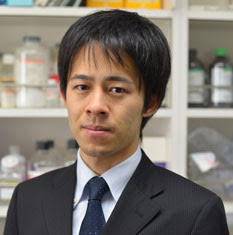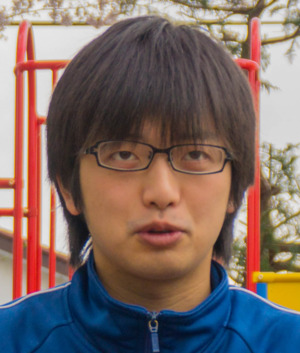Invited Talks Abstracts & Key words
- Short Talks 10:20 ~ 12:10 and 15:00 ~ 16:00, April 14th Fri
- Session I. 13:10 ~ 14:20, April 14th Fri
- Session II. 14:40 ~ 15:20, April 14th Fri
- Poster Session 15:20 ~ 16:20, April 14th Fri
- Session III. 16:40 ~ 18:30, April 14th Fri
- Session IV. 10:30 ~ 12:20, April 15th Sat
Session I. Automation for high-throughput data aquisiotion in Life Science
Chair: Akira Funahashi(Keio University, Japan)
 |
Prof. Toru Natsume |
| AIST, Japan | |
| Talk Title: LabDroid:all purpose humanoid robot for life science | |
| Author:
Toru Natsume [1, 2]
[1] National Institute of Advanced Industrial Science and Technology(AIST) [2] Molecular Profiling Research Center for Drug Discovery(molprof) |
|
| Abstract: | Robotics and artificial intelligence technologies have been proposed to be integrated
in life science experiments. However, no versatile design of laboratory automation has been
widely accepted and used so far. In this presentation we will propose that a humanoid robot
could be one of the best solutions to migrate us towards laboratory automation.
We have developed a double-arm humanoid, LabDroid (“Maholo”), so that various life science
experimentations can be programmed and performed by the single identical robotic system using
standard laboratory instruments, and without the need for specialized equipments.
With several demonstrations of protocols, we will discuss the concept of “Robotic Crowd Biology”.
In this concept, many researchers would submit protocols on-line to an automated laboratory
and each workflow is performed by a crowd of LabDroid agents minimizing the purchase costs of
expensive instruments which daily produce surpluses at the individual laboratory level.
We also believe that this model would be a strong system that guarantees and validates our
experiments to be innately reproducible and transferable, as is necessary.
|
| Keywords: | Proteomics and Robotics, Artificial Intelligence |
Session II. Innovative techniques for detection and visualization
Chair: Noriko Hiroi(Keio University, Japan)
 |
Prof. Daniel Citterio |
| Keio University, Japan | |
| Talk Title: With paper and office equipment to simple and low-cost analytical devices. | |
| Author:
Daniel Citterio[1]*, Kentaro Yamada[1], Terence G. Henares[1], Koji Suzuki[1]
[1] Department of Applied Chemistry, Keio University, Yokohama, Kanagawa, Japan |
|
| Abstract: | [Background] In the field of clinical diagnostics, there is continuously
growing demand for on-site analytical techniques. In this context, (microfluidic)
paper-based analytical devices (µPADs) have evolved into popular tools for assays
performed by untrained users. They find increasing use for point-of-care-testing
in hospitals or in resource limited settings[1]. Relying on simple paper
substrates makes them extremely low cost and allows for pump-free transportation
of liquids by capillary wicking, overcoming a major disadvantage of conventional
microfluidics. The high surface-to-volume ratio of paper substrates enables
immobilization of reagents required for analytical assays, so that user interaction
is limited to simple sample application. [Methods] We focus on classical printing approaches for the fabrication of µPADs. Of particular interest is the inkjet printing technology, because it allows the contactless and highly precise deposition of picoliter volumes of liquids onto paper substrates[2]. Other pieces of office equipment, such as wax printers, paper cutters and hot laminators further contribute to the simple and highly reproducible fabrication of µPADs. A second important component for µPAD fabrication are (bio)chemically functional printing inks, which are used to inkjet deposit reagents and additives required for (bio)chemical assays on paper. [Results] The first example shows the quantification of the glycoprotein lactoferrin in human tear fluid, which is of interest in clinical diagnostics of ocular diseases. The conventionally used immunoassay method has been replaced by a chemical assay no longer requiring costly and unstable antibodies. The assay relies on the fluorescence emission of lactoferrin bound terbium (Tb3+) cations[3]. To further simplify the assay method, a “distance-based” signal detection system like an analog thermometer has been developed, replacing computer-based data processing by naked eye direct signal readout[4]. The second example is a µPAD for the detection of Zn2+, Fe2+ and Cu2+. This device introduces a new method of sample transport on paper-based microfluidics, resulting in faster analysis times and lower detection limits[5]. The complete devices, including the immobilization of colorimetric reagents to the paper device surface, can be fabricated on conventional desktop inkjet printers. [Conclusion] It has been demonstrated that simple, single-use microfluidic paper-based analytical devices can be highly reproducibly fabricated with the aid of ordinary office equipment. Some µPADs can compete with much more sophisticated conventional analytical techniques and offer identical results, but at significantly lower cost, within shorter time and without the need for highly skilled instrument operators. [References] 1. K. Yamada, H. Shibata, K. Suzuki, D. Citterio*. “Toward practical application of paper-based microfluidics for medical diagnostics: State-of-the-art and challenges”. Lab on a Chip, in press, doi: 10.1039/c6lc01577h (2017) 2. K. Yamada, T. G. Henares, K. Suzuki, D. Citterio*. “Paper-based inkjet-printed microfluidic analytical devices”. Angewandte Chemie International Edition 54, 5294-5310 (2015) 3. K. Yamada, S. Takaki, N. Komuro, K. Suzuki, D. Citterio*. “An antibody-free microfluidic paper-based analytical device for the determination of tear fluid lactoferrin by fluorescence sensitization of Tb3+”. Analyst 139, 1637-1643 (2014) 4. K. Yamada, T. G. Henares, K. Suzuki, D. Citterio*. “Distance-based tear lactoferrin assay on microfluidic paper device using interfacial interactions on surface-modified cellulose”. ACS Applied Materials & Interfaces 7, 24864-24875 (2015) |
| Keywords: | printed devices, microfluidics, colorimetry, tear protein analysis, metal ion analysis |
 |
Dr. Yuki Hiruta |
| Keio University, Japan | |
| Talk Title: The design of smart polymer probes for cellular imaging. | |
| Author:Yuki Hiruta, and Hideko Kanazawa
[1] Faculty of Pharmacy, Keio University, Tokyo |
|
| Abstract: |
[Background] The discrimination of normal and tumor cells is so attractive from a clinical viewpoint.
However, the consistent different between normal and tumor cells are often not sufficient to distinguish them.
Tumorous extracellular pH (average pH 6.8) is a slightly lower than that of normal tissue and
the physiological pH of arterial blood (pH 7.4).
Poly(N-isopropylacryl-amide) (PNIPAAm) exhibits a reversible temperature-responsive phase transition
at a lower critical solution temperature (LCST) in aqueous solution. The LCST of PNIPAAm-based polymer
can be precisely controlled to near body temperature for biomedical applications by copolymerization with
hydrophilic monomers. Furthermore, PNIPAAm-based copolymer was functionalized with pH responsive characteristic
by copolymerization with pH-responsive monomer. In this presentation, the design of temperature- and
pH-responsive polymer probes, and its temperature- and pH-dependent intracellular uptake will be described [1-3].
[Methods] Temperature- and pH responsive polymers with carboxyl end-groups were synthesized by radical polymerization. LCST of polymers were determined as the temperature at 50% optical transmittance of polymer solutions (0.5w/v%) at 500 nm. Temperature- and pH-dependent hydrodynamic diameters were determined by the dynamic light scattering (DLS) method. Terminal carboxyl groups were labeled with amino fluorescein, and fluorescence polymer probes were obtained. Temperature- and pH-dependent intracellular uptakes were visualized by microscope. The quantitative analysis of fluorescence polymer probes internalized into cells was measured by flow cytometer. [Results] Obtained temperature- and pH-responsive polymers exhibited temperature- and pH-dependent phase transition. The hydrodynamic diameters of these polymers drastically increased at temperatures greater than phase transition temperature, indicative of the change from hydrophilic to hydrophobic characteristic, followed by polymer aggregation caused by hydrophobic interactions. The temperature- and pH-dependent intracellular uptakes of amino fluorescein labeled polymers were evaluated with changing incubation conditions. Temperature- and pH-dependent intracellular uptakes were visualized with fluorescence microscopy images, and quantified with flow cytometry fluorescence histograms. [Conclusion] Temperature- and pH-responsive fluorescence polymer probes were successfully designed and synthesized. Temperature- and pH-dependent intracellular uptakes opens up the visualization of tumors at the cellular level, which may offer the potential for development/use as a diagnosis tool for early tumor detection. [References] 1. Y. Hiruta, M. Shimamura, M. Matsuura, Y. Maekawa, T. Funatsu, Y. Suzuki, E. Ayano, T. Okano, H. Kanazawa*. “Temperature-Responsive Fluorescence Polymer Probes with Accurate Thermally Controlled Cellular Uptakes”. ACS Macro Letters 3, 281-285 (2014) 2. Y. Hiruta*, T. Funatsu, M. Minami, J. Wang, E. Ayano, H. Kanazawa. “pH/temperature-responsive fluorescence polymer probe with pH-controlled cellular uptake”. Sensors and Actuators B: Chemical 207, 671-677 (2015) 3. Y. Hiruta*, R. Nemoto, H. Kanazawa. “Design and synthesis of temperature-responsive polymer/silica hybrid nanoparticles and application to thermally controlled cellular uptake”. Colloids and Surfaces B: Biointerfaces 153, 2-9 (2017) |
| Keywords: | temperature-responsive polymer, pH-responsive polymer, intracellular uptake, phase transition, fluorescent imaging |
Session III. Dynamic Cellular Decisions
Chair: Akatsuki Kimura
 |
Takumi Hiraiwa |
| Systems Biology Laboratory, Department of Biosciences and Informatics, Keio University | |
| Talk Title: High sensitivity to Wnt3a gradient in orientation of ODF2/cenexin of neuroblastoma cells. | |
| Author:
Takumi Hiraiwa[1], Yuichiro Nakai[1], Takahiro Yamada[1], Ryuichi Tanimoto[1], Hiroshi Kimura[2],
Yoshinori Matsumoto[3], Norihisa Miki[4], Noriko Hiroi[1] and Akira Funahashi[1]
[1]Department of Biosciences and Informatics, Keio University, Japan. [2]Department of Mechanical Engineering, Tokai University, Japan. [3]Department of Applied Physics and Physico-Informatics, Keio University, Japan. [4]Department of Mechanical Engineering, Keio University, Japan. |
|
| Abstract: |
Asymmetric cell division is considered to be one of the triggers of cell differentiation and tissue development.
Wnt3a is a notable candidate for contributing to asymmetric cell division.
However, the sensitivity of cells to Wnt3a signalling in deciding axis of cell division has not yet been analysed.
We develop a microfluidic cell culture device, which can produce a gradient of signalling molecules to test
the sensitivity of cells to Wnt3a signalling for controlling the axis of cell division.
We confirm that 1 ~ 6 x 10-3 nM/$\mu$m concentration gradient of Wnt3a is detected by cells and
has an effect on the decision about the orientation of the asymmetric distribution of ODF2/cenexin between
mother centrioles by late mitotic phases. Our results suggest that differences of only a few molecules in
the receptor occupancy at both sides of an after-metaphase cell may be detected to control the axis of
mitotic elements.
|
| Keywords: | Asymmetric Cell Divisikon, cell differentiation, Wnt3a |
 |
Prof. Kozo Tanaka |
| Department of Molecular Oncology, Institute of Development, Aging, and Cancer, Tohoku University, Japan | |
| Talk Title: Alterations in chromosome dynamics impair the fidelity of chromosome transmission. | |
| Author:
Kozo Tanaka[1]
[1]Department of Molecular Oncology, Institute of Development, Aging, and Cancer, Tohoku University, Japan |
|
| Abstract: |
The majority of cancer cells show chromosomal instability (CIN), a condition in which chromosome missegregation
occurs at a high rate. As defects in critical mitotic processes are lethal, CIN in cancer cells supposedly arise
from defects in non-essential processes that allow cell survival. Merotelic attachment, an erroneous attachment
of kinetochores to microtubules, plays a major role in the generation of CIN, by escaping the spindle assembly
checkpoint and forming lagging chromosomes that result in chromosome missegregation. We found that efficient
chromosome movement towards the spindle equator and subsequent chromosome oscillation around the spindle equator
are important for high-fidelity chromosome transmission. We propose that these non-essential processes play
a causal role in the generation of CIN through the formation of merotelic attachment.
|
| Keywords: | chromosomal instability, spindle equator, chromosome transmission |
 |
Dr. Viji M Draviam |
| Queen Mary University of London, UK | |
| Talk Title: Mechanisms that ensure the accurate segregation of human chromosomes. | |
| Author:
Duccio Conti [1], Roshan Shrestha [2], Viji M Draviam[3]
[1] Department of Genetics, University of Cambridge, Cambridge, UK [2] National Institutes of Health, Bethesda, USA [3] School of Biological and Chemical Sciences, Queen Mary University of London, London, UK |
|
| Abstract: |
Throughout life, the process of cell division ensures the proper replenishment of dead or injured cells.
When a cell divides into two, microtubules capture and pull chromosomes apart into two equal sets.
My research group studies how human cells ensure the accurate segregation of chromosomes using a combination
of high-resolution microscopy, biochemistry and molecular biology techniques. Chromosome-microtubule
attachment is facilitated by a macromolecular structure called the kinetochore. Our work and others’
have contributed to the identification of kinetochore proteins that are essential for establishing and
monitoring chromosome-microtubule attachment, and in turn chromosome segregation fidelity.
I will present our recent work which shows that chromosomes are first captured along the walls of microtubules
and then brought to the ends of microtubules without detachment by a process called end-on conversion.
Errors in the end-on conversion process can lead to chromosome mis-segregation.
I will conclude with a brief overview of ongoing research efforts to discover the master regulators of
the end-on conversion process that are essential to maintain a stable genome.
|
| Keywords: | Chromosome Segregation, Microtubules, Mitosis, Kinetochore |
Session IV. Advances in Microscopy & Image Analyses tools
Chair: Akira Funahashi(Keio University,Japan)
 |
Prof. Aki Kimura |
| National Institute of Genetics, Japan | |
| Talk Title: Measurement of intracellular forces using centrifuge polarization microscope (CPM). | |
| Author:
Aki Kimura[1, 2]
[1] Cell Architecture Laboratory, National Institute of Genetics, Shizuoka [2] Department of Genetics, SOKENDAI (The Graduate University for Advanced Studies), Shizuoka |
|
| Abstract: | The nucleus is positioned at the cell center in most cells. The central positioning of
the nucleus is thought to be critical for equatorial cell division because it provides
the basis of central positioning of the mitotic spindle and the cleavage furrow.
In spite of its generality and importance, the mechanism behind the central positioning of
the nucleus is still controversial. One of the major challenges to understand the mechanism is
to measure the forces produced inside the cell to position the nucleus. Once we know
the amount of the forces, we will be able to evaluate candidate hypotheses quantitatively
whether they can produce enough force for the centration. To measure the forces, we utilized
the Centrifuge Polarizing Microscope (CPM) developed at the Marine Biological Laboratory [1].
With this microscope, we can image a cell while applying a centrifugal force to it. Because
the density of the nucleus is different from that of the surrounding cytoplasm,
such centrifugal force should move the nucleus. By quantifying the relationship between
the centrifugal force and the movement of the nucleus, we will be able to know
the amount of force acting inside the cell to move the nucleus. We examined the centration of
the nucleus in the 1-cell stage embryo of Caenorhabditis elegans [2–4]. I will show how
the nucleus moved inside the cell with centrifugal forces, and discuss what the results imply.
[References] 1. S. Inoué, R.A. Knudson, M. Goda, K. Suzuki, C. Nagano, N. Okada, H. Takahashi, K. Ichie, M. Iida, M. Yamanaka. “Centrifuge polarizing microscope. I. Rationale, design and instrument performance”. Journal of Microscopy 201, 341–356 (2001) 2. A. Kimura, S. Onami. “Computer simulations and image processing reveal length-dependent pulling force as the primary mechanism for C. elegans male pronuclear migration.” Developmental Cell 8, 765–775 (2005) 3. A. Kimura, S. Onami. “Local cortical pulling-force repression switches centrosomal centration and posterior displacement in C. elegans.” Journal of Cell Biology 179, 1347–1354 (2007) 4. K. Kimura, A. Kimura. “Intracellular organelles mediate cytoplasmic pulling force for centrosome centration in the Caenorhabditis elegans early embryo.” Proc Natl Acad Sci USA 108, 137–142 (2011) |
| Keywords: | Centrifuge Polarizing Microscope (CPM), Caenorhabiditis elegans, nuclear centration, microtubule |
 |
Dr. Hiro Oku |
| Gunma University, Japan | |
| Talk Title: Fundamental study on ultra high-speed 3D biological imaging using a tunable acoustic gradient (TAG) index device | |
| Author: Hiro Oku[1]
[1] Department of Electronics and Informatics, Gunma University, Gunma, Japan |
|
| Abstract: |
[Background] Three dimensional biological imaging with high temporal resolution is important
for understanding biological phenomena in cells, and many approaches has been reported,
such as digital holographic microscope (DHM) [1], light field microscope[2],
and optical microscope with z-scan[3]. The z-scan approach is instinctive extension of the conventional microscope.
But, this approach had the well-known drawback, the limited scan-speed due to the lack of the adequate optical device/mechanism.
However, many new optical devices that can control its focal length with quite high-speed has been appeared recently,
and the drawback could be expected to be solved by utilizing such devices. [Methods] In this presentation, the z-scan mechanism for optical microscopy using liquid lens technology will be discussed. Potential applications of real-time processing of sequential images acquired through z-scan are also explained. In addition, our current project using a tunable acoustic gradient (TAG) index device that has micro second order temporal resolution is introduced. [Conclusion] The z-scan approach is relatively simple and instinctive extension of the conventional microscope. This approach has the advantages: 1. most observation methods used in the current optical microscope can be used, and 2. high-speed processing of the acquired images is possible. [References] 1. M. Molaei, J. Sheng*. “Imaging bacterial 3D motion using digital in-line holographic microscopy and correlation-based de-noising algorithm”, Opt. Express 22, 32119 (2014) 2. N. Cohen* et al. “Enhancing the performance of the light field microscope using wavefront coding”, Opt. Express 22, 24817 (2014) 3. Y. Nakai, et al. “High-speed microscopy with an electrically tunable lens to image the dynamics of in vivo molecular complexes”, Rev. Sci. Instrum. 86, 013707 (2015) |
| Keywords: | microscope, liquid lens, z scan, TAG lens |
 |
Dr. Stephen Wu |
| Institute of Statistical Mathematics, Japan | |
| Talk Title: Whole neural network analysis of C. elegans using an automated image processing pipeline | |
| Author: Stephen Wu[1], Terumasa Tokunaga[2,3], Osamu Hirose[1,2,4], Yu Toyoshima[2,5],
Takayuki Teramoto[2,6], Yuishi Iwasaki[2,7], Takeshi Ishihara[2,6], Yuichi Iino[2,5], Ryo Yoshida[1,2]
[1]Institute of Statistical Mathematics, Research Organization of Information and Systems. Tachikawa, Tokyo, Japan [2] JST-CREST [3] Kyushu Tech. [4] Kanazawa University, Japan [5] University of Tokyo, Japan [6] Kyushu University [7] Ibaraki University |
|
| Abstract: |
Recent advancement in pan-neural imaging technology of C. elegans brings us
a big step toward fully understanding the underlying mechanism of
how a neural network controls behaviors of a living organism.
We now have the essential hardware that releases us from only studying a single
or a small subset of neurons at a time. However, the software that can
efficiently and reliably produce a large data set of neural activities from
raw whole brain images of multiple C. elegans is still missing. In this talk,
I will present our progress on the development of an automated pan-neural image
processing pipeline, and demonstrate some potential scientific discoveries
using this technique.
|
| Keywords: |